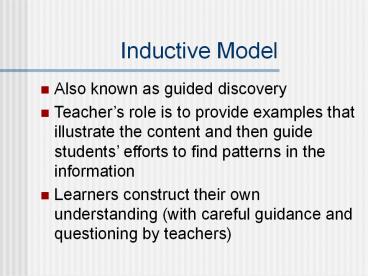Inductive Model - PowerPoint PPT Presentation
Title:
Inductive Model
Description:
Characteristics of the Inductive Model. Highly sophisticated and demanding instruction ... CAR: exemplars are Ford Taurus, Toyota Camry. Concept Analysis. It ... – PowerPoint PPT presentation
Number of Views:254
Avg rating:3.0/5.0
Title: Inductive Model
1
Inductive Model
- Also known as guided discovery
- Teachers role is to provide examples that
illustrate the content and then guide students
efforts to find patterns in the information - Learners construct their own understanding (with
careful guidance and questioning by teachers)
2
Sample Lessons
- Judy Nelsons longitude and latitude
- Sue Grants behavior of gases
- Jim Rooneys rules for punctuating singular and
plural possessive nouns
3
An Overview
- Each topic was specific and well defined
- Each teacher presented chosen examples and then
guided the students as they formed their
conclusions - Each teacher used a variety of teaching
strategies to guide students to the correct
conclusion(s) - The students used basic cognitive skills to move
from the examples to the conclusions
4
Characteristics of the Inductive Model
- Highly sophisticated and demanding instruction
- Teachers must be expert in questioning
- Teachers must monitor behavior
- Teachers must make on the spot decisions about
what questions to ask and which students to call
on - The students must be guided to analyze the
information
5
Theoretical Foundations
- Lessons using Inductive Model begin with and are
built around examples - These examples become the experiences that
learner use to construct their understanding of
the topic
6
Theoretical Foundations
- Social interaction is used to analyze the
examples. Social interaction and teacher
guidance will help eliminate misinterpretation of
the examples
7
Theoretical Foundations
- The teacher guides the students. It is a dual
role - (1) accepting and honoring the students
inventions of knowledge (even when they are
wrong) while at the same time - (2) guiding the students toward a more mature
understanding
8
Concepts
- Categories with common characteristics
- Mental categories, sets, or classes
- Latitude is a concept
- Rectangle is a concept
- Perspective in art is a concept
- The number of concepts in the school curriculum
is nearly endless
9
A Concepts Characteristics
- A concepts characteristics are its defining
features - Example Rectangle
- Common Characteristics
- Opposite sides equal in length
- Opposite sides parallel
- All interior angles are 90 degrees
10
Some Concepts are Fuzzy
- Example Cars
- Best to present a fuzzy concept using either
prototypes or exemplars - Prototypes are the best representatives of its
class - Exemplars are the most highly typical members of
its class. - USA prototype of democracy
- CAR exemplars are Ford Taurus, Toyota Camry
11
Concept Analysis
- It includes the following
- Definition
- Characteristics
- Examples
- Superordinate concept (larger category)
- Subordinate concept (subsets of the concept)
- Coordinate concept (related subset of the
superordinate category)
12
Example Adjective
- Definition part of speech, modifies a noun
- Characteristics modifies a noun
- Examples old car, exciting game, home team
- Superordinate concept parts of speech
- Subordinate concept Predicate adj.
- Coordinate concept Adverb
13
The Keys to Making Concepts Understandable
- A clear definition
- Carefully selected examples
- Carefully selected nonexamples
14
Relationships among Concepts
- Principals relationships among concepts accepted
as valid for all known cases - Principles are also known as laws
- Example All like magnetic poles repel, unlike
magnetic poles attract
15
Relationships among Concepts
- Generalizations general patterns with known
exceptions - Example a daily dose of aspirin reduces the
danger of a heart attack - This is generally accepted as good medical
practice, but there are exceptions for certain
medical conditions
16
Relationships among Concepts
- Academic rules relationships between concepts
arbitrarily derived by people - Example Rounding
- The rule is Round up a number if the last digit
is 5 or higher - We could have set the last digit at 6 or higher,
we have arbitrarily set it at 5 or higher
17
Planning Lessons with the Inductive Model
- Identify topic
- Specify learning objective(s)
- Identify examples and nonexamples
- Use quality examples
- Use a variety of examples
- Use real world examples
- Use concrete materials
- Use pictures
- Use models
- Use vignettes (case studies)
- Use technology and computer software
18
Implementing Lessons Using the Inductive Model
- Phase 1 Introduction
- The focus of the lesson is established
- The teacher attracts students attention
- The teacher activates curiosity and motivates
students - Poses a problem to solve
- Reviews previous material on subject
19
Implementing Cont.
- Phase 2 The open-ended phase
- Students make observations and comparisons that
are used for further analysis - With examples and nonexamples
- Teacher promotes involvement by asking open-ended
questions - Teacher ensures success
20
Implementing Cont.
- Phase 3 The convergent phase
- Teacher narrows the range of student responses
and assists them in identifying the essential
characteristics of a concept, or guides students
to a generalization, principle, or academic rule
21
Implementing Cont.
- Phase 4 Closure
- Students summarize or state correct conclusions
22
Implementing Cont.
- Phase 5 Application
- To insure transfer, students must be able to
apply their knowledge outside the classroom - Teachers provide opportunities for students to
relate the topic to the real world - Independent seatwork
- Homework
- Teachers link new knowledge to previously learned
knowledge
23
Characteristics of Inductive Model
- Emphasizes critical, higher-order thinking
- Increases student motivation
- Learner involvement and success
- Evokes curiosity and challenges students to find
an unknown - Examples provide background information to
accommodate individual differences - Creative model peaks student interest
24
Assessing Student Learning
- Assessment must match teacher objectives
- You can use
- Traditional paper and pencil assessments
- Assessments that capitalize on real world contexts































